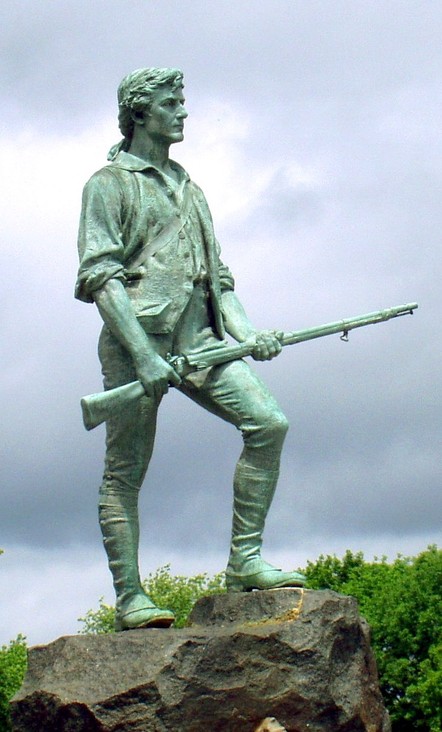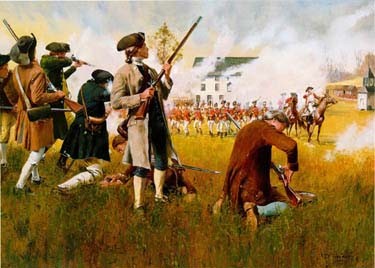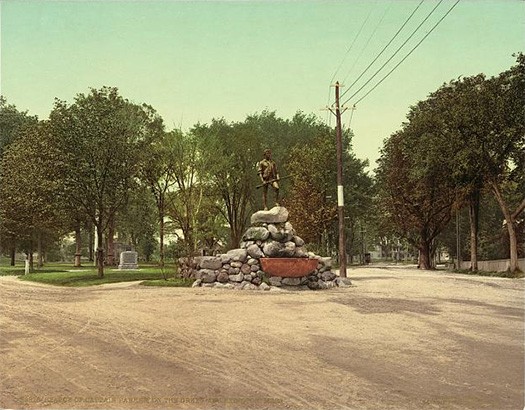Lexington Minuteman Statue
Introduction
Text-to-speech Audio
Images
The Lexington Minuteman has stood this ground since the statue's dedication in 1900.

"Stand Your Ground" depicts the first fighting of the Revolution on Lexington Common (Oil on hardboard, by Don Troiani, 1985)

This is an early photograph of the Lexington Minuteman, taken two years after its unveiling in 1900. Courtesy of the Library of Congress.

Backstory and Context
Text-to-speech Audio
The statue of the Lexington Minuteman stands on the southeast corner of the Lexington Battle Green at the intersection of Bedford Street and Massachusetts Avenue. It was unveiled on April 19, 1900, the 125th anniversary of the historic first battle of the American Revolution. The statue was created as a memorial to the Minutemen’s heroics, while its fountain served as a source of water for people and their animals.
The fountain/statue’s construction was funded by a $10,000 bequest from Francis Brown Hayes, a prominent New England lawyer and businessman who had lived in Lexington. Hayes was an executive at several different railroad companies, including a four-year tenure as President of the Atlantic and Pacific Railroad. He was also elected as a member of the Massachusetts House of Representatives, the Massachusetts Senate, and was the President of the Massachusetts Horticultural Society at the time of his death in 1884.
The town of Lexington selected Henry Hudson Kitson to sculpt the Minuteman statue. Kitson was an English-born artist who emigrated to the United States around 1877-1878. He was the creator of several public monuments in and around the Boston area as well as several more in the Vicksburg National Military Park in Mississippi and Louisiana. The statue depicts a colonial farmer standing on top of the native fieldstone base. Tradition also claims the statue represents Captain John Parker, the leader of the Lexington militia in 1775. Various men served as models for the Minuteman, including Medford resident Arthur Mather. The base symbolized the strength of the colonial patriots living in Massachusetts during this era. The statue also included a drinking trough for horses, which has since been converted into a planter. The total cost of the monument was just over the amount bequeathed by Hayes ($10,853). In 1989, the Town of Lexington constructed a small traffic island across from the statue to give tourists a safe spot to take their photographs.
Minutemen were a group of patriotic individuals who provided a highly mobile and rapidly deployed force that allowed the colonies to respond quickly to the threat of war. In Massachusetts, colonial law required all able-bodied men between the ages of 16 and 60 to be part of the local militia. The minutemen consisted of specially-trained volunteer companies within the militia. They were expected to keep their weapons and equipment with them at all times. In the event of a conflict, they were ready to jump into action at a minute's warning, hence their nickname.
While the Lexington Minuteman is often associated with Captain John Parker, whose men participated in the first skirmishes of the American Revolution, he actually led a group of militia. On April 19, 1775, Parker's militia met British troops arriving at Lexington. The two sides exchanged fire leaving 8 militiamen dead and 10 wounded, while one British soldier was injured in the fighting. Word quickly spread that the British were marching to Concord, where additional militia companies, along with minutemen, attacked. The Americans continued their attacks as the British retreated back to Boston, passing through Lexington once again along the way. These clashes have become known as the first battles of the American Revolution.
The minutemen, notable for their bravery, patriotism, and skill, are among the most well-known figures of the American Revolution, often symbolizing the American spirit. The statue at Lexington is part of a larger history of commemorating their service to the United States.
Cite This Entry
Kraft, Sean et. al. "Lexington Minuteman Statue." Clio: Your Guide to History. April 19, 2018. Accessed August 14, 2025. https://theclio.com/entry/12661
Sources
Hannigan, John. "Men of Color." Minute Man National Historical Park. Accessed April 2018. https://www.nps.gov/mima/upload/PoC-Paper-4-SoC-on-April-19-Final-for-Web.pdf
"Francis Brown Hayes (1819-1884)." Old Berwick Historical Society. Accessed May 06, 2017. http://oldberwick.org/index.php?option=com_content&view=article&id=644:30-middle-street&catid=31:gen....
Library of Congress."Today In History - July 13." Library of Congress. Accessed May 06, 2017. https://www.loc.gov/item/today-in-history/july-13/.
Mausolf, Lisa. Minute Man Statue. Lexington Historical Commission. September 2009. Accessed May 06, 2017. http://historicsurvey.lexingtonma.gov/objects-structures/minuteman902.pdf.
Minuteman Statue. Visit Lexington Massachusetts: The Birthplace of American Liberty. Accessed May 06, 2017. http://www.tourlexington.us/attractions/pages/minuteman-statue
National Park Service. "Minute Man." Minute Man National Historical Park. Last updated March 31, 2012. Accessed December April 2018. http://www.nps.gov/mima/general-history-questions.htm
New England Historic Genealogical Society. Memorial Biographies of the New England Historic Genealogical Society. The Society, 1907. ebook at https://books.google.com/books?id=A3MtAAAAYAAJ&dq=francis+brown+hayes&source=gbs_navlinks_s
Smithsonian Institution. "Minuteman (sculpture)." Art Inventories Catalog. Smithsonian American Art Museum. Accessed April 2018. https://siris-artinventories.si.edu/ipac20/ipac.jsp?session=P52T1E8978351.1060&profile=ariall&source...

